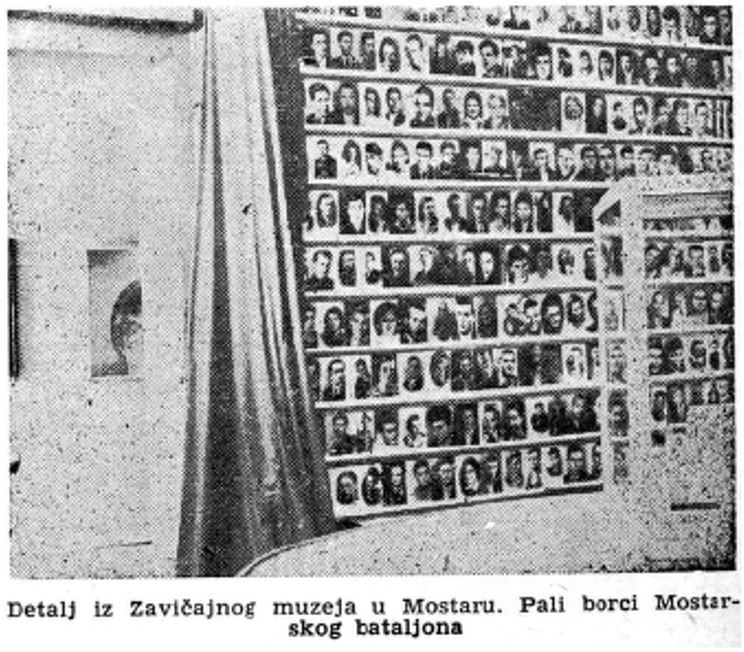Since the original documentation is unavailable, it is difficult to determine the exact number of those buried with certainty.
According to data held by the VAM Center in Belgrade—based on historical literature and press, as well as statements from Bogdan Bogdanović, Radmilo Braco Andrić, and others—it involves at least over 300 fighters. There is also a quote from the Commission for the Preservation of Monuments which mentions ‘560 remains of fallen fighters, including 8 People’s Heroes.’
Radmilo Braca Andrić, mayor of Mostar from 1969 to 1974 and later part of the commission for the reconstruction of the Partisan Memorial Cemetery, in a video interview (around the 2nd minute) mentions the remains of over 200 fighters: “somewhere around 200 and something are in the common ossuary there where wreaths are laid. These are the remains of partisans who died mostly in the Chetnik coup.”
An article published in the newspaper “Sloboda” during the opening of the Partisan Memorial Cemetery in September 1965, mentions that there were “common graves of fighters who died in Dramiševo, Kamena, Glavatičevo – Bjelimići, and Ovojci”. This would match the above statement by Braco Andrić.
There is also a quote from the Monument Preservation Commission which mentions “560 remains of fallen fighters, including 8 national heroes.”
The following fallen fighters were killed in those locations by Ustashe &/or during the Chetnik coup:
Aleksandar M. ALAGIĆ (1923. Gospić – 1943. Bijela), Hivzija M. BRKIĆ (1919. Mostar – 1942. Bijela), Hasan A. BUBIĆ (1914. Mostar – 1943. Bijela), Remzija S. ĆIŠIĆ (1923. Mostar – 1942. Bijela), Ibro I. DIZDAREVIĆ (1923. Mostar – 1942. Bijela), Šefko H. DUGALIĆ (1920. Mostar – 1943. Bijela), Milan V. IVETIĆ (1909. Mostar – 1942. Bijela), Risto S. KANDIĆ (1903. Prigrađani – 1942. Bijela), Milorad B. PIKULA (1924. Mostar – 1943. Bijela), Mehmed S. ŠAPUH (1922. Mostar – 1942. Bijela), Elefif S. ŠARAN (1921. Mostar – 1942. Bijela), Stjepan S. ŠULENTIĆ (1914. Mostar – 1942. Bijela), Muhamed O. TASLAMAN (1920. Mostar – 1942. Bijela), Mehmed D. ZALIHIĆ (1888. Mostar – 1942. Bijela)
Ante A. ZUANIĆ (1924. Rogatica – 1942. Bjelimići)
Risto V. MILIĆEVIĆ (1921. Mostar – 1942. Zvijerina), Bisera M. SALAHOVIĆ (1924. Trebinje – 1942. Zvijerina)
Abdulah S. DIZDAREVIĆ (1906. Ljubuški – 1942. Dramiševo), Ibrahim A. DŽAFEROVIĆ (1920. Gacko – 1942. Dramiševo), Muhamed M. HADŽIOMEROVIĆ (1918. Mostar – 1942. Dramiševo), Mustafa M. KRESO (1914. Mostar – 1943. Dramiševo), Pero V. LAŽETIĆ (1921. Mostar – 1942. Dramiševo), Mustafa M. REPAK (1920. Mostar – 1942. Dramiševo), Hidajet H. ŠARIĆ (1924. Mostar – 1942. Dramiševo), Salko M. ŠEHOVIĆ (1917. Mostar – 1942. Dramiševo)
Mladen D. BALORDA, narodni heroj (1921. Mostar – 1943. Ovojci), Ljubo B. BREŠAN, narodni heroj (1913. Dubrovnik – 1943. Ovojci), Šaćir I. ČELEBIĆ (1922. Mostar – 1943. Ovojci), Džemal S. DELIĆ (1921. Mostar – 1943. Ovojci), Muzafer H. DERONJA (1924. Mostar – 1943. Ovojci), Hamdija S. DIZDAREVIĆ (1923. Mostar – 1943. Ovojci), Ibrahim H. ĐUKIĆ (1923. Mostar – 1943. Ovojci), Omer H. ĐUKIĆ (1925. Mostar – 1943. Ovojci), Abduselam M. ELEZOVIĆ (1924. Mostar – 1943. Ovojci), Radojka R. GNJATIĆ-IVANIŠEVIĆ (1918. Mostar – 1944. Ovojci), Anđelko E. GOATTI (1893. Mostar – 1943. Ovojci), Ćamil M. HADŽAJLIĆ (1907. Mostar – 1943. Ovojci), Meho I. HUSKOVIĆ (1905. Mostar – 1943. Ovojci), Smajo M. IBRULJ (1922. Ljubuški – 1943. Ovojci), Đorđo D. JANJALIJA (1919. Mostar – 1943. Ovojci), Pero D. JANJALIJA (1913. Mostar – 1943. Ovojci), Smajil A. JUGO (1919. Mostar – 1943. Ovojci), Ibro M. KAZAZIĆ (1913. Mostar – 1943. Ovojci), Nafik S. KAZAZIĆ (1921. Mostar – 1943. Ovojci), Šefkija M. KOMADINA (1907. Mostar – 1943. Ovojci), Mirko P. KONJEVOD (1924. Mostar – 1943. Ovojci), Jusuf J. MALKOČ (1906. Mostar – 1943. Ovojci), Krunoslav R. MILIĆEVIĆ (1923. Mostar – 1943. Ovojci), Osman A. NOŽIĆ (1924. Mostar – 1943. Ovojci), Mehmed M. PALA (1921. Mostar – 1943. Ovojci), Avdija M. PAVLOVIĆ (1902. Mostar – 1943. Ovojci), Teofik A. PUZIĆ (1914. Mostar – 1943. Ovojci), Halid H. SADIKOVIĆ (1918. Ljubuški – 1943. Ovojci), Alija H. SALKOVIĆ (1913. Mostar – 1943. Ovojci), Ahmet A. SEFIĆ (1918. Mostar – 1941. Ovojci), Muhamed H. ŠIŠIRAK (1920. Mostar – 1943. Ovojci), Zijad H. VRGORA (1926. Mostar – 1943. Ovojci), Slobodan G. VUKOVIĆ (1919. Mostar – 1941. Ovojci), Zlatka VUKOVIĆ (1893. Mostar – 1941. Ovojci)
Muhamed O. HOJLAŠ (1921. Mostar – 1942. Česim), Branko V. KOSJERINA (1907. Trebinje – 1942. Česim)
Džemal O. DRAGNIĆ (1920. Mostar – 1941. Glavatičevo), Nedžad H. HAĆAM (1920. Lukavac – 1942. Glavatičevo), Mujo I. HUBANA (1916. Humilišani – 1942. Glavatičevo), Suzana Š. LAKATOŠ (1922. Novi Sad – 1942. Glavatičevo), Miloš R. RACO (1913. Mostar – 1942. Glavatičevo), Vasko P. VUKIČEVIĆ (1923. Mostar – 1944. Glavatičevo)
Among national heroes:
Dr. Safet Mujić – a copy of a document from 1966 states that his mortal remains were transferred to Partisan Memorial (source: spomeniciNOB.info), Ljubo Brešan, Jusuf Čevro, Mustafa Ćemalović, Rifat Frenjo, Ahmet Pintul, Hasan Zahirović Laca.
Other fallen fighters buried here include: Muhidin Bašagić, Salko Šestić, Alija Rizikalo, Drago Palavestra. There are statements from individuals about their family members being transferred to the memorial ossuary – see Šestić and Kosjerina.
The list is not exhaustive and may be often updated.

